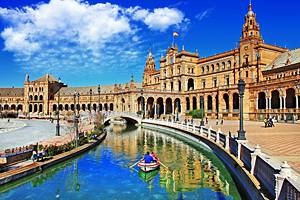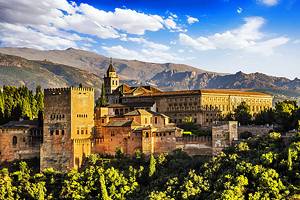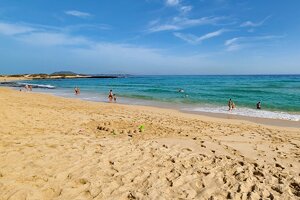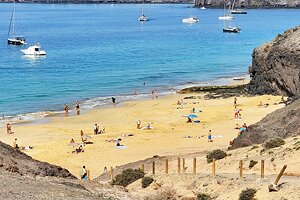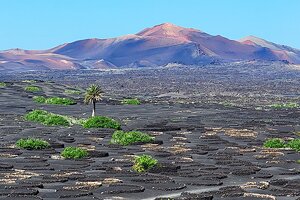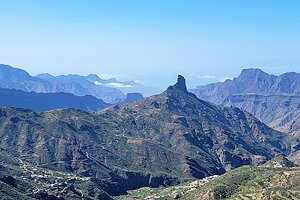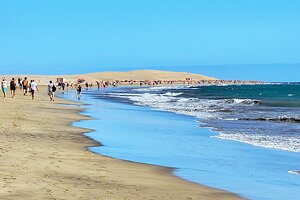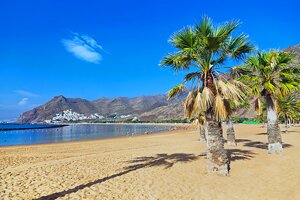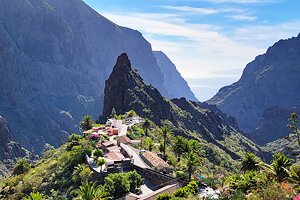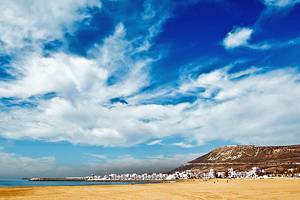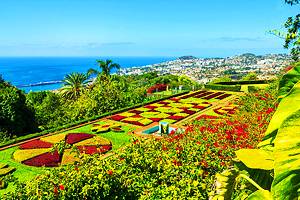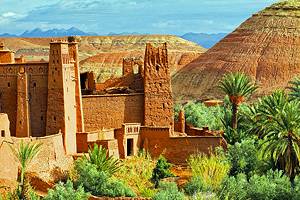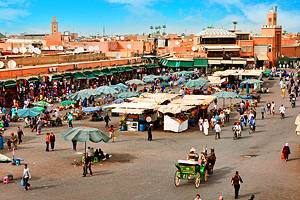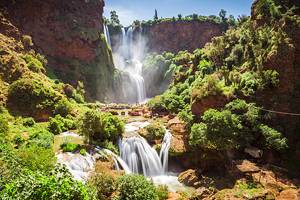Things to Do on Fuerteventura
Authors Michael and Lana Law island-hopped through the Canary Islands and enjoyed their time on Fuerteventura.
Fuerteventura is the island loved by those interested in a beach holiday. This long, slender island is the home of the Canary Islands' most beautiful stretches of blindingly white sand lapped by crystalline waters.

But it's not all about the beach. The island also has a decent assortment of interesting things to do on and off the sand. Some of the best places to visit are the pleasant little towns with good dining options, the rugged interior for a little adventure, and the wild Atlantic coastline where your only company will be the seabirds.
Explore all the island has to offer with our list of attractions and things to do in Fuerteventura.
Relax on a Beach

For most tourists, the main reason for coming to Fuerteventura is to lie on a beach and bask in the sun. Many of the resorts and holiday destinations are clustered around the beaches in the south of the island.
Fuerteventura's beaches are as varied as they are spectacular. A mix of developed, manmade, and wild and uninhabited beaches are all on offer. Most are easy to get to; a couple require a bit of perseverance to reach.
Beaches in the South of Fuerteventura: In the far south at Morro Jable, the wonderful Playa del Matorral is a popular beach that fronts a lively tourist town packed with restaurants and shops.

Up for an adventure? Take the 45-minute drive on a dusty, rough road across a lunar landscape to the wild side of the island and spend a bit of time on the legendary Playa de Cofete. This huge sweep of sand is backed by mountains. While you're out here, swing by the mysterious Casa Winter, a relic from WWII that may have been a spy outpost.
Perhaps one of the most beguiling and beautiful beaches is Playa de Sotavento. Impossibly huge and shallow, this beach is one of the best beaches for families on Fuerteventura. The water slowly comes in and out with the tides, making small pools ideal for wading and lolling about. Once a month for about a week, the tides come in during the day and create a huge shallow lagoon where kiteboarders and windsurfers can race across the water when the wind is up.

Beaches in the north of Fuerteventura: In the north, the best beaches are located within and near the Parque Natural Corralejo. These beaches are huge, wide sections of beach that stretch out almost endlessly. Some of these are developed, and others are just beautiful roadside stops. One of the unique features is the massive sand dunes behind.
Located in the park is the Hotel Riu Olive Beach Resort, a mid-range option with a pool. The real advantage of staying here is the location, right on the beach, and you can walk out onto the sand dunes.
Play in the Dunes at Parque Natural Corralejo

One of the true highlights of a visit to Fuerteventura is a day spent at Parque Natural Corralejo. This stunning 2,600-hectare park is a sight to be seen and experienced. Massive sand dunes flow back from the water's edge, and the white sands contrast sharply with the dark volcanic peaks in behind.
The main road, FV-104, passes through the park and it's easy, in most places, to pull off and go sightseeing. Let your inner Lawrence of Arabia loose and climb to the top of the dunes (minus the camel, of course!) for spectacular views in all directions. The farther back you get from the water, the larger the dunes. Be prepared for a shoeful of sand after your expedition.

The dunes are only part of the attraction here. The coastline is, for most sun-starved people, the main highlight. Beaches stretch for miles northwards with clear, cool water lapping up against impossibly white sands. Pictures don't quite do this stretch of beach justice — the stunning cobalt waters are a sight to behold.
One of the park's beaches, Playa Alzada, is one of the most popular places to visit on the island to learn how to surf. Swimming at the park's beaches is naturally a popular pastime; lifeguard stations are posted along the most popular parts of the beach.
The park, unlike some other national parks in Spain, is free to enter.
One very important tip to remember if you are driving: do not pull off the highway into the soft sand. If you do, you'll become hopelessly bogged down, and a tow-out is very expensive.
Read More: Attractions & Places to Visit in the Canary Islands
Oasis Wildlife Park Fuerteventura

If you've had enough of the beach or you have a rare bad weather day and are looking for something to do with the kids, make the trip to the Oasis Wildlife Park. This massive zoo features over 3,000 animals and is home to the largest cactus garden in Europe.
Oasis Park features live animal performances by sea lions and birds of prey and many others. If you want to get up close and personal with the animals, consider one of the one-on-one encounters. These are available with giraffes, lemurs, sea lions, camels, and elephants for an additional fee.
Address: Museo del Campo Majorero, Carr. Gral. Jandía, s/n, 35627 La Lajita, Las Palmas, Spain
Take a Scenic Drive

Fuerteventura is a place that just begs to be explored. Each part of the island is quite different from the other, and with the distances being relatively short, it doesn't take long to go from one interesting area to another.
Many of the top sights are along the east coast. If you start from either Corralejo or Morro Jable, you'll be able to see them all in a day. Without stops, it takes about two hours to drive one way between the two places, but count on a full day to really enjoy the trip.
Depending on where you're starting from, head up or down the coast on FV-2, which is the main highway running north-south on the island. You can drive this route in both directions, and the view is different each way. Or, if you prefer, return through the center along FV-10, FV-20, FV-30, FV-511, and FV-56.
The entire trip is about 300 kilometers in total.
Dune Buggy Trips

If you are looking for some off-road adventure, consider signing up for a 2.5-hour Fuerteventura off-road excursion. You'll get off the beaten track with your powerful 600cc dune buggy and explore some areas of the island that many people never get to see up close.
It's a dusty and dirty experience that takes you along both paved roads and dirt tracks. Highlights include a stop at the sand dunes (which you are not allowed to drive on), a trip through a vast volcanic landscape, and a few laps around a figure-eight race course.
The dune buggies are a popular family thing to do on Fuerteventura. Anyone with a driver's license can drive.
Morro Jable Town

Home to some of Fuerteventura's best beaches, Morro Jable is the place where you'll most likely end up if you've arrived on an air/hotel package trip. Huge resorts line the hills above the stunningly beautiful Playa de Jandia, and sun seekers fill the loungers on the golden sands.
The town is a lively and fun place, with countless restaurants that feature menus created with tourists in mind. You'll have no trouble locating a decent Indian curry, hamburger, or mushy peas. Spanish restaurants also make the scene here, with traditional mainland and Canary Island fare.
Take a stroll down Avenida del Saladar and do a bit of shopping at the unique shops selling souvenirs right through to some of the latest fashions. Or, if you prefer a bit more nature in your stroll, wander out to the beach past the Morro Jable Lighthouse and walk along the seashore.
Surfing

If you've ever wanted to try surfing, Fuerteventura is an excellent place to give it a try. The island boasts plenty of experts offering surf lessons. The breaks here are perfect for beginners, with shallow water and easy entries. For those who need a bigger challenge, jumbo reef waves are on offer and are not for the faint of heart.
The best time to surf in Fuerteventura is in the fall, followed closely by the winter. Spring is iffy, and summer is a washout. The water is cool; most people wear shorty wetsuits to ensure they can stay out as long as possible.
One of the most popular spots to learn surfing is at Playa Alzada. A gentle beach break makes it easy to get your first ride, and as you advance, the break at the southern end of the beach provides a bit more excitement and longer rides.
You'll find 14 main surf spots, plus a few more if you get to know the locals well enough, that will provide lots of wave-riding action.
Kiteboarding

Fuerteventura is one of the top destinations for kiteboarders visiting the Canary Islands. Wide-open beaches and strong, consistent winds make for the ideal combination, ensuring adrenaline-filled days out on the ocean.
Most of the action takes place at Flag Beach, also known as Playa del Medano. This long stretch of golden brown, almost white sand, makes for an excellent launch and landing spot. There's nothing quite like racing along the water here with the peak of Isla de Lobos off in the distance. The wind blows steadily, and occasionally gustily, out of the northeast, and the shore break can be a bit tricky for less experienced riders.

Another spot that is known for having the ever-coveted flat water that every kiteboarder craves, is near Playa Punta Aguda. This is for advanced riders only. If you crash your kite and end up washing ashore, the razor-sharp lava rock will likely destroy your gear.
If you've not tried the sport, the local kite shop, Flag Beach Kitesurfing Centre will hook you up with gear and lessons.
Corralejo Town

This town at the northern end of Fuerteventura is one of the main ports on the island and where you'll arrive by ferry if coming across from Lanzarote. Home to many of the island's inhabitants, the town is a mix of locals and visitors and exudes a relaxed air.
Corralejo has a pleasant waterfront area with a couple of small beaches. Back from the beaches are waterside restaurants with pleasant patios offering wonderful views out to Isla de Lobos. In the center of town is a pedestrian-only walkway with additional restaurants and shops.
If you are staying in a condo and need to stock up on supplies, Corralejo is the place to do it.
Faro de Toston

For a fun trip that's a bit off the beaten track, make the journey out to the Faro de Toston (Toston Lighthouse). Located in the far northwestern region of the island, this lonely sentinel stands guard at the entrance to the Bocaina Strait between Fuerteventura and Lanzarote.
The original lighthouse dates from 1897, and it has been expanded outwards and upwards several times since then to now stand at nearly 40 meters high. Inside the lighthouse is the small, but interesting Museum of Traditional Fishing.
The area around the lighthouse has some of Fuerteventura's most striking coastline. Ancient lava flows meet the sea, and jagged black rocks shelter small, spectacular beaches. It's frequently windy here, and if it's blowing hard, kiteboarders can be seen just offshore racing back and forth under colorful kites.
Address: 35650 La Oliva, Las Palmas, Spain
Acua Water Park

If the kids have had enough of the beach or you are just looking for something different, consider a day at Acua Water Park. Spread out over 25,000 square meters, this splish-splashy world of water and fun is a must-do family activity.
The park boasts 14 different water features ranging from traditional waterslides right through to a giant wave pool. See how brave you are by taking a ride down the Kamikazes, a steep and straight high-speed slide. For something with twists and turns that will have you unsure of which way is left or right, try the curved slides.
Over at the wave pool, you can ride different-sized waves or frolic under the waterfalls. Out of the water, you'll find a snack bar and a Children's Club complete with games and face-painting experts.
The Acua Water Park is located in Corralejo, just look for the giant pirate at the front entrance.
Address: Av. Ntra. Sra. del Carmen, 41, 35660 Corralejo, Las Palmas, Spain
Museo de la Sal

As you drive south or north on the island, a quick pit stop at the Museo de la Sal (Salt Museum) is worthwhile. This low-key attraction provides insight into the process of making salt from seawater. Numerous displays explain the process in a well-done museum.
Outside the museum building are the salt ponds. They are well worth a look, and information boards provide additional insight. Perhaps the Salt Museum's most interesting thing to see is the colony of small Barbary squirrels. These active little guys are non-stop entertainment for people of all ages. You'll find them right by the pathway in a pile of rocks on the righthand side.
Address: Barrio las Salinas, 2, 35610 Antigua, Las Palmas, Spain
Fuerteventura (La Oliva) - Climate Chart
| Average minimum and maximum temperatures for Fuerteventura (La Oliva), Spain in °C | |||||||||||
| J | F | M | A | M | J | J | A | S | O | N | D |
| 21 14 | 22 14 | 22 15 | 22 16 | 23 17 | 24 18 | 25 19 | 26 21 | 26 21 | 26 19 | 24 18 | 22 16 |
| PlanetWare.com | |||||||||||
| Average monthly precipitation totals for Fuerteventura (La Oliva), Spain in mm. | |||||||||||
| 25 | 18 | 13 | 5 | 3 | 0 | 0 | 0 | 3 | 5 | 15 | 25 |
| Average minimum and maximum temperatures for Fuerteventura (La Oliva), Spain in °F | |||||||||||
| J | F | M | A | M | J | J | A | S | O | N | D |
| 70 57 | 72 57 | 72 59 | 72 61 | 73 63 | 75 64 | 77 66 | 79 70 | 79 70 | 79 66 | 18 64 | 72 61 |
| PlanetWare.com | |||||||||||
| Average monthly precipitation totals for Fuerteventura (La Oliva), Spain in inches. | |||||||||||
| 1.0 | 0.7 | 0.5 | 0.2 | 0.1 | 0 | 0 | 0 | 0.1 | 0.2 | 0.6 | 1.0 |


